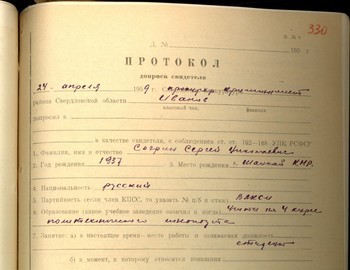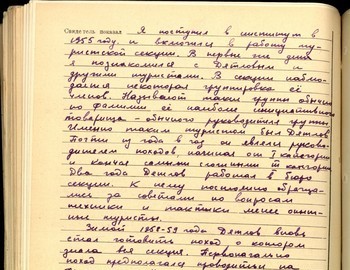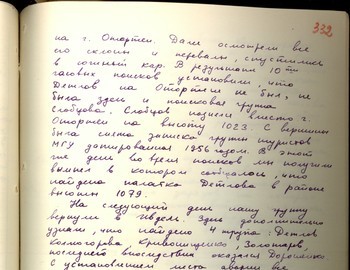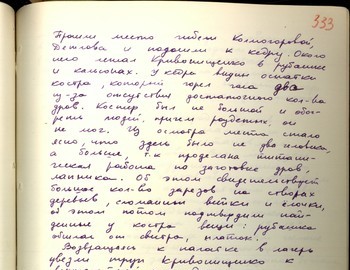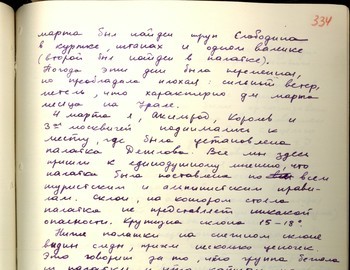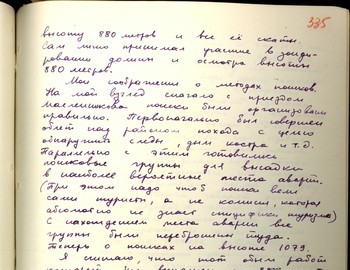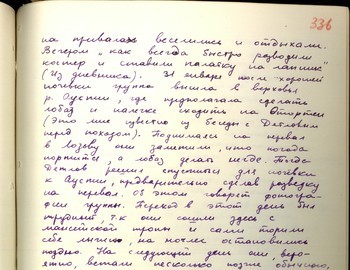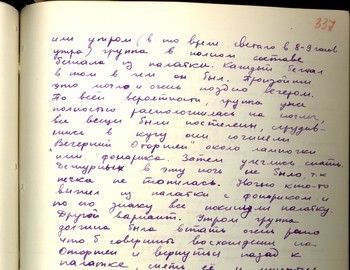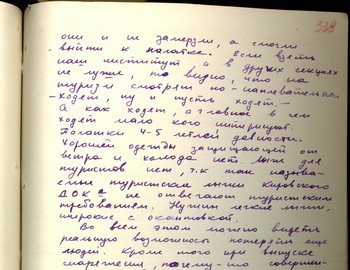
S. N. Sogrin witness testimony
Protocol
witness testimony
On 24 April 1959, in compliance with Article 162-168 of the Code of Criminal Procedure of the RSFSR, the prosecutor criminologist of Sverdlovsk region Ivanov interrogated as a witness
- Surname, name and middle name: Sogrin Sergey Nikolaevich
- Year of birth 1937
- Place of birth: city of Shanghai, China
- Nationality: Russian
- Political affiliation: member of the Komsomol
- Education (what school graduated from and when): 4th year student in the Polytechnic Institute
- Occupation: a) currently: student, b) at the moment of the events: -
- Criminal record: no
- Permanent residence: city of Sverdlovsk, Kirov St 18
- Passport: -
- Relation to the accused: -
Warned on the responsibility for the first part of Art. 92 of the Criminal Code of the RSFSR for refusing to testify and under Art. 95 of the Criminal Code of the RSFSR for giving knowingly false testimony.
Witness testified: I enrolled in the institute in 1955 and started working in the hiking section. In the first days I met with Dyatlov and other hikers. In the section there is a certain grouping of its members. These groups are usually named after the most initiative comrade - the usual leader of the group. Dyatlov was the kind. Almost from year to year he was the leader of the expeditions, beginning from the category I and ending with the most difficult category III. Two years Dyatlov worked in the bureau section. Less experienced hikers always turned to him for advice on technology and tactics.
In the winter of 1958-1959, Dyatlov began to prepare new expedition of which the whole section knew. Initially, the expedition was supposed to be carried out in the Subpolar Ural, but since this area required a lot of time, it was abandoned and the Northern Ural was chosen - the region is easier and more accessible. I myself was also in midst of a preparation of a category III trip to the Subpolar Ural, and Dyatlov and I often talked about our routes, shared our experience, jointly decided on some or other issues of preparation, tactics on the route.
On January 23, the Dyatlov group left Sverdlovsk, four hours later my group left as well. I returned to Sverdlovsk on 24 February. 3-4 hours after my arrival a member of my trek Sedov came to me and said that Dyatlov group had not met the deadline.
Together with him we went to the institute, where we met Milman L. S., who knew nothing more about what happened than we did. The trade union committee organized round-the-clock duty, groups were being prepared for the search. The most active participation in the organization of all searches in Sverdlovsk these days was taken by the chairman of the trade union committee, V. E. Slobodin.
The next day, i.e. February 25, I flew to Ivdel. On the same day, flew Akselrod, Tipikin, Yaburov, Chiglintsev. The last two as radio operators. They landed in Artemovskiy to get radio stations; but they were completely unsuitable for rescue (weighed about 200 kg). After 3-hour negotiations with Sverdlovsk, the radio factory had to carry only 2 stations (the plane did not take any more), which were completely unnecessary. In the evening there was a meeting of the commission, which invited me and Akselrod. From all that I learned there, it became clear that the real and planned searches began only with the arrival of comrade Maslennikov, since the company that gathered there was not at all competent in matters of tourism and organizing rescue operations.
I was assigned to Akselrod group and on February 26 we flew with a helicopter to the eastern ridge of Mt Otorten. Our task included a thorough survey of the junction of Mt Otorten and all its slopes, because it was considered the most likely site of the accident. On February 27, Akselrod, Tipikin and I left the camp on the Sulpa river
in Mt Otorten. Then we examined all its slopes and passes. We went down to the south. As a result of 10-hour searches found out that Dyatlov group didn't reach Otorten, and Slobtsov group was also no where to be seen. Slobtsov flew to height 1023 instead of Mt Otorten. From the top was taken down a note left by a group of MGU (Mining Geographical University - ed. note) hikers dated 1956. On the same day, during the search, we were dropped a canister in which it was a note saying that Dyatlov group tent had been found near the height 1079.
The next day our group flew back to Ivdel. Here, in addition, we learned that four bodies were found: Dyatlov, Kolmogorova, Krivonischenko, Zolotaryov, the latter later turned out to be Doroshenko. With the establishment of the accident site, all search groups were recalled and transferred to the area of the accident. Head of the search operation at height 1079 was appointed Maslennikov.
On the first of March I, Akselrod, Tipikin, Ivanov L. N. were dropped at the scene of the accident. We were greeted by a large group of people tightly wrapped in and wearing ski caps. The wind blew snow in the face and tried to throw you off the plateau. Quickly loaded into the helicopter Dyatlov group belongings and several people. Behind the large cliff lay 3 bodies already pulled up to the helipad. Despite the bad weather weather went on a search. The probing of the slope started, but because of the bad weather and the lack of experience of the search participants, there was no much effectiveness.
We passed the place of the death of Kolmogorova and Dyatlov and approached the cedar. Near the tree lay Krivonischenko in a undershirt and underpants. At the cedar the remains of the fire are visible, which burned for about 2-3 two hours due to lack of enough firewood. The fire was not big to heat barely clad people. From the inspection of the site it became clear that there were more than two people, because of the massive work was done on the preparation of firewood and spruce. This is evidenced by a large number of cuts on the trunks of trees, broken branches and fir-trees, this was later confirmed by the items found at the fire: a shirt cuff from a sweater, a handkerchief.
Returning to the tent in the camp, we took Krivonischenko's body to the helipad. The next day, due to a hurricane, blizzard and lack of visibility it was impossible to work and everyone returned to the camp. Near the camp we found the cache site (aka labaz) of Dyatlov group. The labaz was well equipped, the products found in it testified to the good thorough preparation of the group for the expedition. On March 3, the weather improved somewhat. We decided to divide the whole area of \Dyatlov/ group incident into sections and searched with probes every meter. Outside this area were sent groups for free search for external inspection of suspicious locations. Searches were conducted according to this plan until March 8th. As a result of the 5th of
March Slobodin's body was found in a jacket, pants and one valenka (the second was found in the tent). The weather was variable these days, but the prevailing was a bad one: strong wind, blizzard, which is typical for the month of March in the Urals.
On March 4, I, Akselrod, Korolyov and 3 Muscovites ascended to the place where the Dyatlov's tent was pitched. All of us here came to the unanimous opinion that the tent was set by all hikers and mountaineering rules. The slope on which the tent stood is not dangerous. The steepness of the slope is 15-18°.
Below the tent on the snow slope are footprints, in several tracks. This indicates that the group fled from the tent and didn't roll on the slope. If we assume that someone left the tent and for some reason fell down, then he would have flown no more than 10-20 meters. In this case, always, with the strongest wind, there was a real chance to return to the tent. Go back to the tent from the cedar, which is located 1.5 km down the slope, without shoes it is impossible even for the strongest person.
On March 7, the planned scope of work was completed. We probed the whole valley from the tent to the cedar in the length of 1.5 km and width of 300 to 400 m. Probing was also done around the cedar in a radius of 200 meters. We did free search of whole valley of Lozva river, as well as
height 880 meters and all the surrounding slopes. I personally took part in the probing of the valley and inspection of height 880 meters.
My thoughts on the methods of searching. In my opinion, with the arrival of Maslennikov, the searches were organized correctly. Initially, air search was conducted over the hiking area in order to detect tracks, smoke of a fire, etc. At the same time search groups were being prepared for disembarkation to the most probable accident sites. (At the same time it is necessary that the searches were conducted by the hikers themselves, and not by the commision, which is clueless about the specifics of tourism). With the location of the accident, all the groups were transferred there. Now about the search at the height 1079.
I believe that the volume of work that was carried out before March 8th gave full grounds for stopping the search till the snow melts. This is evidenced by the experience of rescue work in the mountains. For observation and free search it was possible to leave a group in 5-6 people. Other methods of searching like trench digging or anything else under these conditions would be unacceptable, because there was no avalanche, no snowfall.
When the melting of the snow begins, it is necessary to use dogs in the search, traces of animals rising from hibernation.
Now about the movement of Dyatlov group along the route. The first days of the hike were normal. The group was keenly interested in all they saw (Mansi signs)
They enjoyed themselves on the trek and rested. In the evening, "quickly start a fire and pitch the tent on fir branches" (from the diary) on January 31, after a good night's rest, the group reached the upper sourses of Auspiya river, where they planned to make a labaz and go lightly to Otorten (I know this from a conversation with Dyatlov before the expedition). Climbing on the pass to Lozva, they noticed that the weather was deteriorating, and there is no good place for the the labaz. Then Dyatlov decided to go down for an overnight stay on Auspiya, having previously made a reconnaissance to the pass. The photos of the group speak about this. That day's hike was difficult, because the Mansi trail ended and they had to break the snow themselfs, stopped late for the night. The next day they probably got up a little later than usual, they decided to do the cache site, since the place was convenient. It took a lot of time to prepare firewood, which was not enough around, for dividing the food supplies. After lunch, the group headed out in the direction of Otorten according to the planned plan they made the day before, after the reconnaissance. Seeing from the pass a deep descent to Lozva, Dyatlov decided to go along the top, which is much more convenient than moving through thin snow in the valley from where you can not see anything. Therefore, on February 1, the group did not go down from the pass, but went further along the slope towards Otorten. In the evening the tent was installed on slope of 1079.
For unknown reasons, in the night,
or in the morning (at that time daylight started at 8-9 AM) the group in full force fled from the tent. Everyone fled in what he was. It could have happen very late in the evening. In all likelihood, the group has already completely settled down for the night, all things were bedded, huddled together in a heap they wrote "Evening Otorten" on the light of a flashlight. Then they lay down to sleep. The stove that night was not used so there was no one on duty. At night someone came out of the tent with a flashlight and on his sign all left the tent. Another variant. In the morning the group had to get up very early to climb Otorten and go back to the tent, take it apart and go down to the labaz where the wood for the stove was left. During dressing and breakfast, the group, frightened by something, ran away from the tent. It could be at 5 o'clock, and at 6, or even earlier. I myself went on a hike in the Subpolar Urals and raised my group at 4 AM, so we can climb Mt Neroyka at 6 AM.
In mountaineering practice we get up even earlier, which, of course, Dyatlov knew. The effect of the external factor that caused the group to leave the tent, apparently, was quite long, because to go down barefoot 1.5 km (with no hesitation) takes some time. Once in this position, they froze, showing
colossal will in the struggle for life.
In my opinion. the members of Dyatlov group that are not found yet were also at the fire, but having warm clothes, and most importantly shoes, went in the direction of the 2nd North breaking the snow. Not having the strength to fight with deep snow without skis, they also froze somewhere. They did not return to the tent, thinking that it was not there, or afraid to return to it.
Dyatlov's trip to the area did not represent anything unusual. This area of the north of the Sverdlovsk region has been developed by hikers for a long time. Every year there are a group of hikers on vacation. Dyatlov himself was in that area, but somewhat to the south in 1957, I was in that area in 1958.
On the route itself, there were no violations of the group, judging by the diary, the schematics of the path. The composition of the group was quite experienced and well selected, i.e. everyone knew each other well from joint trips. Therefore, the group had a formal and real right to go on a similar expedition. As for the preparation of all the documentation of the trip before leaving, I didn't take interested, because I was busy getting ready with my own expedition.
About the equipment. the provision of the equipment was as for any other hiking group. And the equipment is disgusting. If they had better gear, good jackets, maybe
they wouldn't freeze, and could have gone back to the tent. If we take our institute, other sections are not any better, then it is clear that tourism is viewed as a splurging - go, well, let them go - but how they go, and most importantly, in what they go we are not interested in. Tents are 4-5 years old. There are no decent clothes that protect from the wind and cold. There is no skis for hiking. The so-called hiking skis of Kirov Wood processing plant (Кировский Дерево Обрабатывающий Комбинат - ed. note) is issuing do not meet the sports requirements. They should be light skis, wide with metal edging.
In the current situation there is real chance that more people are lost. In addition, when releasing equipment, for some reason, they absolutely do not care about reducing its weight. A heavy backpack is a big burden for hikers. It is often difficult to get the right high-calorie and light concentrates.
Now about the rescue service. It seems to me that in each district it is necessary to create rescue squad with an inviolable fund of equipment, food, radio stations. Such rescue squads need to have for their use a plane, or a helicopter. All groups going to the area must notify the rescue squad and obtain permission from them.
The rescue squad should open or close areas if going there is dangerous.
Sogrin (signature)
Prosecutor-criminalist Ivanov (signature)

